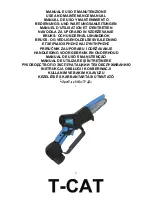
6
GB/IE
–
7KHJHQHUDWLRQRIQRLVHLVLQÀXHQFHGE\YDULRXV
factors, including the characteristics of saw
blades, condition of saw blade and electric
tool. Use saw blades which were designed for
reduced noise development, insofar as possible.
Maintain the electric tool and tool attachments
regularly and if necessary, initiate repairs in
order to reduce noise.
–
Report faults on the electric tool, protective
devices or the tool attachment to the person
responsible for safety as soon as they are dis-
covered.
3
Safe work
-
Make sure that a suitable saw blade for the mate-
rial to be cut is selected.
-
Never use the machine to cut other materials as
VSHFL¿HG
-
To transport the machine follow the procedure
of point 9.
When transporting the electric tool, only use the
transport devices. Never use the protective de-
vices for handling or transport.
-
Operate the machine only if the protective devices
are functional, in good condition and in the correct
position.
-
7KHÀRRUDURXQGWKHPDFKLQHPXVWEHOHYHOFOHDQ
and free of loose particles, such as chips and cut-
ting residues.
-
Only use saw blades for which the maximum
permissible speed is not lower than the maximum
spindle speed of the machine and which are suit-
able for the material to be cut.
-
Be sure to only use spacers and spindle rings
VSHFL¿HGE\WKHPDQXIDFWXUHUDVVXLWDEOHIRUWKH
intended purpose.
-
Attention! Do not replace the laser by a different
type.
Repairs may only be carried out by the manufac-
turer or an authorized representative.
-
Do not remove any cutting residues or other parts
of workpieces from the cutting zone while the ma-
chine is running and the saw unit is not at rest.
Instructions for proper and safe sawing:
a)
Clamp the workpiece always at the saw table
¿UPO\7KHUHIRUHSOHDVHXVHWKHVXSSOLHGFODPSLQJ
device.
b)
Make sure that the machine is secured before
each sawing;
c)
If necessary attach the machine to a workbench
or the like.
Fasten the machine to the workbench, using the
KROHVDWWKH¿[HGVDZWDEOH
d)
Support long workpieces (e.g. with a roller table)
to prevent them sagging at the end of a cut.
e)
Make sure that the saw blade does not touch
the rotary table in any position by pulling out the
mains plug and rotating the saw blade by hand in
the 45° and 90° position. If necessary, readjust the
saw head.
Warning!
This electric tool generates an electromag-
QHWLF¿HOGGXULQJRSHUDWLRQ7KLV¿HOGFDQLPSDLUDFWLYH
or passive medical implants under certain conditions. In
order to prevent the risk of serious or deadly injuries, we
recommend that persons with medical implants consult
with their physician and the manufacturer of the medical
implant prior to operating the electric tool.
SAFETY INSTRUCTIONS FOR THE HANDLING OF
SAW BLADES
1
Only use insertion tools if you have mastered their
use.
2
Observe the maximum speed. The maximum
VSHHGVSHFL¿HGRQWKHLQVHUWLRQWRROPD\QRWEH
H[FHHGHG,IVSHFL¿HGREVHUYHWKHVSHHGUDQJH
3
Observe the motor / saw blade direction of rota-
tion.
4
Do not use any insertion tools with cracks. Sort out
cracked insertion tools. Repairs are not permitted.
5
Clean grease, oil and water off of the clamping
surfaces.
6
Do not use any loose reducing rings or bushes for
the reducing of holes on saw blades.
7
0DNHVXUHWKDW¿[HGUHGXFHUULQJVIRUVHFXULQJWKH
insertion tool have the same diameter and have at
least 1/3 of the cutting diameter.
8
0DNHVXUHWKDW¿[HGUHGXFHUULQJVDUHSDUDOOHOWR
each other.
9
Handle insertion tool with caution. They are ideally
stored in the originally package or special contain-
ers. Wear protective gloves in order to improve
grip and to further reduce the risk of injury.
10
Prior to the use of insertion tools, make sure that
all protective devices are properly fastened.
11
Prior to use, make sure that the insertion tool
meets the technical requirements of this electric
tool and is properly fastened.
12
Only use the supplied saw blade for cutting wood,
never for the processing of metals.
Attention: Laser radiation
Do not stare into the beam
Class 2 laser
Protect yourself and you environment from acci-
dents using suitable precautionary measures!
•
Do not look directly into the laser beam with unpro-
tected eyes.
•
Never look into the path of the beam.
•
1HYHUSRLQWWKHODVHUEHDPWRZDUGVUHÀHFWLQJVXU
-
faces and persons or animals. Even a laser beam
with a low output can cause damage to the eyes.
•
&DXWLRQPHWKRGVRWKHUWKDQWKRVHVSHFL¿HGKHUH
can result in dangerous radiation exposure.
0
Summary of Contents for 273098
Page 5: ...16 17 14 15 18 19 25 24 30 29 5 d 31 6 32 35 36 34 e 37 20 36 21 33 38 38...
Page 59: ...54...
Page 60: ...55...
Page 62: ......












































